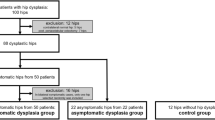Abstract:
We studied the utility of magnetic resonance imaging (MRI) in detecting obstacles to reduction in developmental dysplasia of the hip (DDH) by comparing MRI findings with two-directional arthrograms and intraoperative findings. In 36 patients there were 38 DDHs; 23 complete dislocations and 15 residual subluxations. Coronal and transverse sections of T1-weighted images were used. Interpositions in the acetabulum and the anterior, superior, and posterior portions of the limbus, which were intracapsular obstacles to reduction, were evaluated. MRI and arthrography were useful for assessing the shape of the anterior portion of the limbus. In complete dislocations, MRI findings proved more valuable to detect deformities of the posterior portion of the limbus. Four of ten limbus excisions showed intermediate intensity signals on MRI. The histology was characterized by reparative granulation tissue with new capillary formation and organized thrombi. MRI proved useful for detecting obstacles to reduction, as well as for assessing morphological and histological abnormalities.
Similar content being viewed by others
Author information
Authors and Affiliations
Additional information
Received for publication on June 12, 1998; accepted on Dec. 24, 1998
About this article
Cite this article
Aoki, K., Mitani, S., Asaumi, K. et al. Utility of MRI in detecting obstacles to reduction in developmental dysplasia of the hip: comparison with two-directional arthrography and correlation with intraoperative findings. J Orthop Sci 4, 255–263 (1999). https://doi.org/10.1007/s007760050101
Issue Date:
DOI: https://doi.org/10.1007/s007760050101




